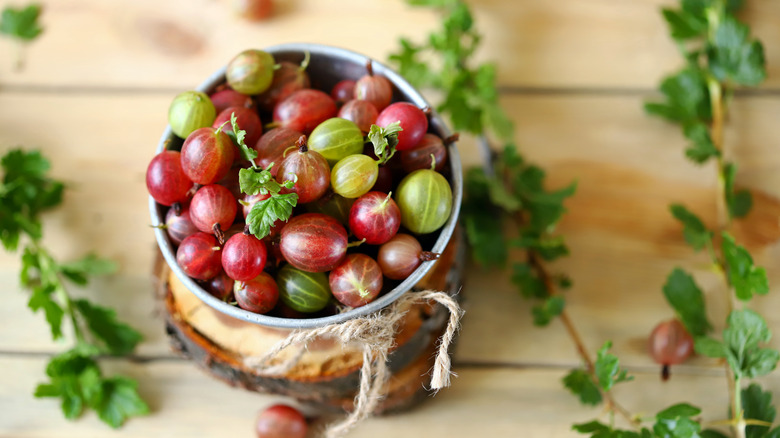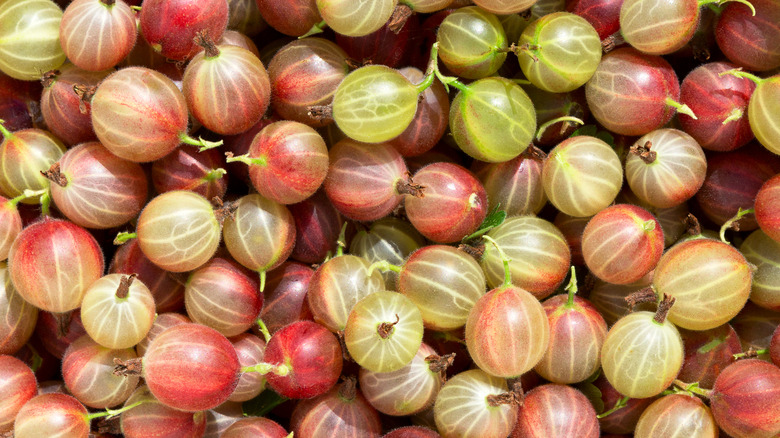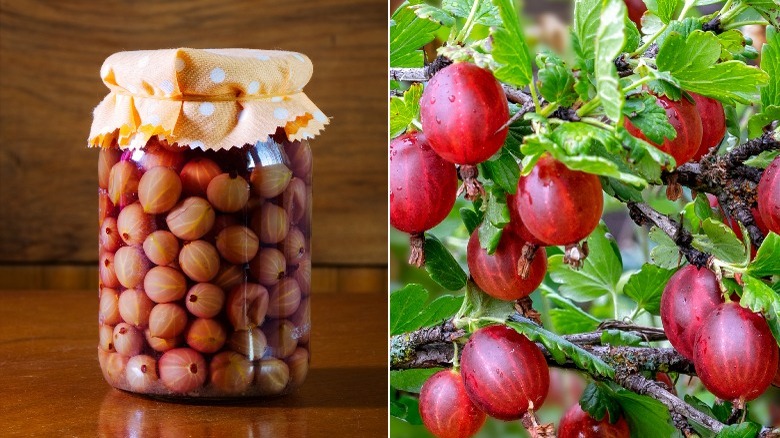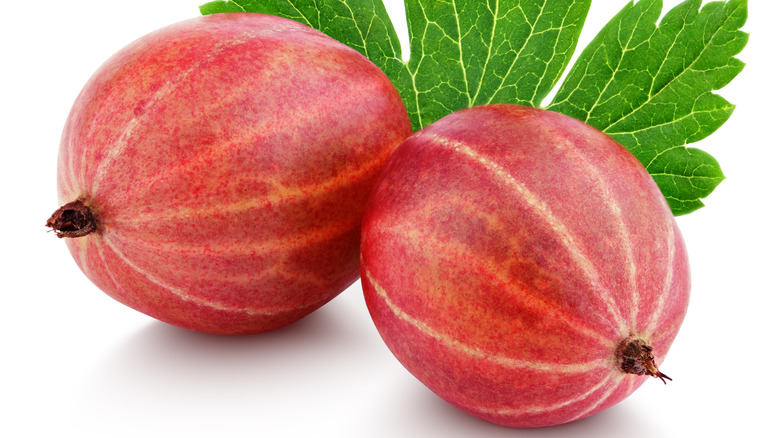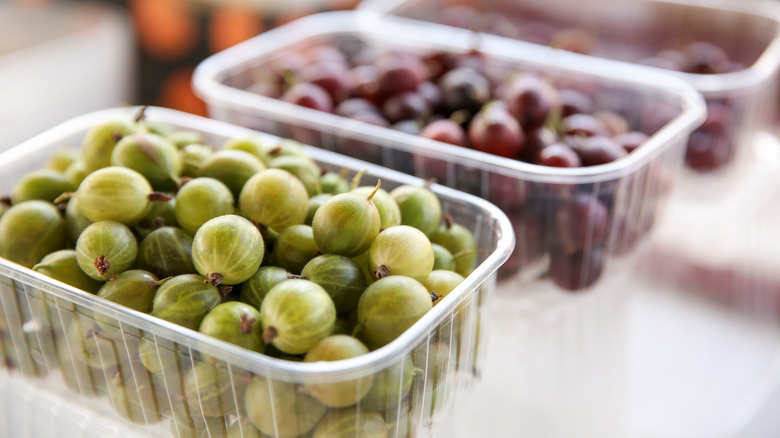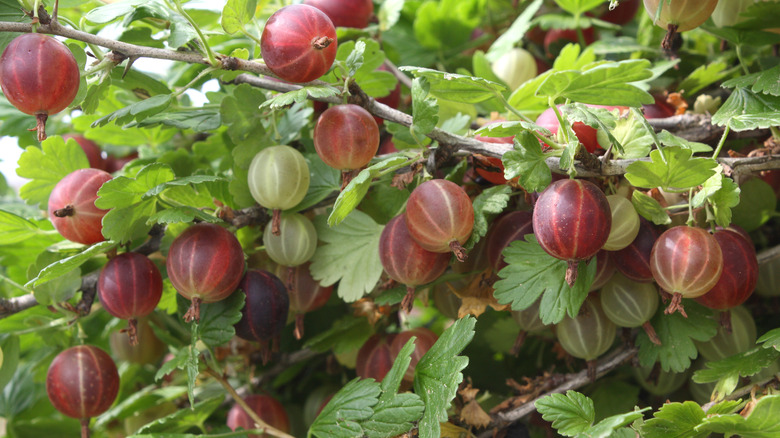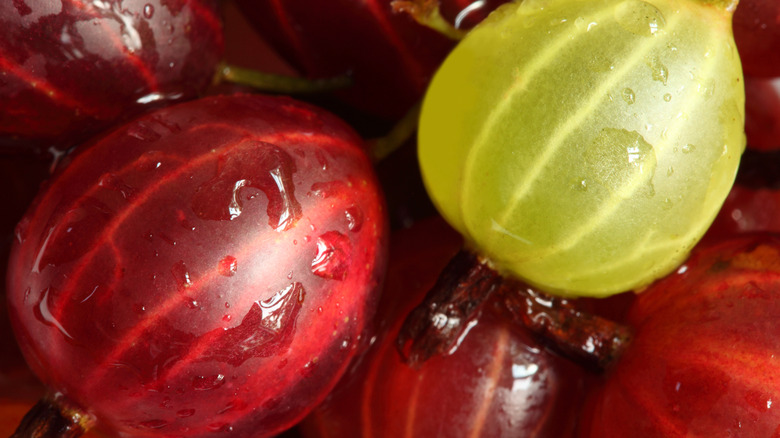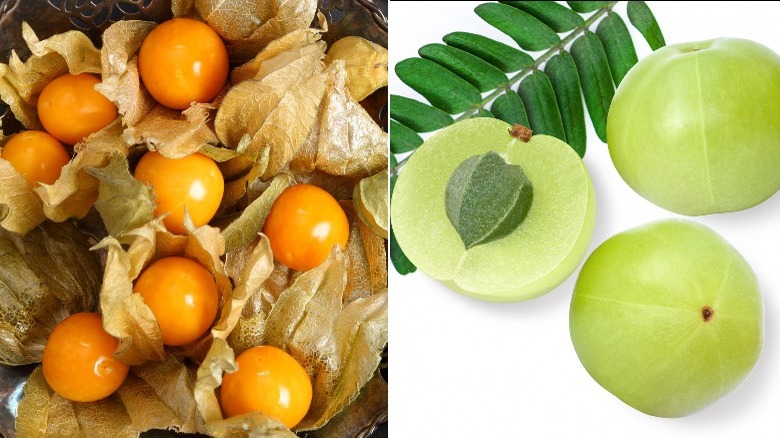What Are Gooseberries And What Do They Taste Like?
Discovering new foods is undoubtedly one of the great joys of eating a diverse diet. And a lot of times that can happen with fresh produce. When it comes to fruit, many are familiar with the name gooseberries, but it can be less common to find them on grocery store shelves. The two main varieties of gooseberries (Ribes uvaicrispa and Ribes hirtellum) grow in select areas of North America and Europe, yet for the most part, they are still among the lesser common fruits lining the produce aisle, per Science Direct. Since their growing season is quite short, you have to know when it's time to keep an eye out for these tasty berries or you might miss them completely.
The name certainly evokes some wild imagery, doesn't it? Is it a goose holding a berry or a berry shaped like a goose? Nonetheless, when it comes down to it, gooseberries have a relatively standard appearance. Their flavor profile spans the spectrum of tart to very sweet, making them a versatile ingredient in the kitchen, too. Whether you want to eat gooseberries fresh, add them to a pie, or stew them to make a sweet jam, gooseberries are up to the task.
What are gooseberries?
The two main varieties of gooseberries are aptly named European and American, providing a helpful clue as to their origin. Indeed, the European type thrives in cooler areas of the continent such as Poland, Russia, and Germany, according to Foods Guy. And BBC Good Food points out that they are also beloved in England, with historical mentions in the Elizabethan era. Agricultural Marketing Resource Center traces the source of the gooseberry to North Africa and the Caucasus. Meanwhile, Britannica reports that the American variety is found in temperate regions of North America, making its way down the continent into the Andes. The source adds that the two varieties are part of the Grossulariaceae family, which also includes currants.
Depending on the ripeness level, gooseberries range from a bright green color similar to a grape, to a darker red and purple shade (via All Recipes). Generally, their sweetness increases as the color darkens, so they give some indication as to what to expect when you source them. Gooseberries are mostly uniformly round, about the size of a marble. And you probably wouldn't expect it from the innocent-looking fruit, but All Recipes explains that gooseberries were banned in many states for a number of years. The choice was wise as the fruit carries a fungal disease that can kill white pine trees. While gooseberries are no longer a threat in some areas, others including North Carolina still prohibit their growth (via Sun Journal).
Fresh vs. canned gooseberries
While it would be great to be able to eat fresh gooseberries year-round, their limited growing season makes it nearly impossible. Thankfully, other options such as freezing and canning are often used to preserve the fruit, says Agricultural Marketing Resource Center. When it comes to fresh gooseberries, they can be consumed green and tart if you wish, though most enjoy them later into their ripening period once they become red or purple and emit sweet aromas. For this reason, they are highly adaptable to a number of preparations.
On the other hand, as Eskom explains, canned gooseberries are harvested when their size reaches a peak, but before they begin to lose firmness and change color. At this point, as the source indicates, the fruit is canned in water or in sugar to preserve it. Of course it is important to note that when the gooseberries are preserved in sugar, their flavor and nutritional profile will vary. Nonetheless, canned gooseberries are a great option if you intend to bake with the fruit or incorporate it into jams or sauces.
What do gooseberries taste like?
Depending on when they are harvested, gooseberries can vary widely in flavor. The skin is always thin and edible and will reveal a juicy interior with tiny seeds that add an extra crunch, says FruitStand. Aside from the extra texture from the seeds, the consistency is not unlike that of a cherry tomato, according to Eat Delights.
At an early stage, when the fruit is still green, you can expect a tart and tangy flavor profile, even possibly bordering on zesty. Similarities to sour grapes, green apples, and lemon are commonly evoked. For this reason, gooseberries are regularly used in baked goods to balance out the added sugar. As the fruit ripens and the sugars increase, expect more aromas and flavors reminiscent of strawberries and muscat grapes (via Eat Delights). Interestingly, gooseberries are often used to describe Sauvignon Blanc wine. In fact, the comparison is not simply made by exuberant wine writers, but due to a compound that is found in both the fruit and the wine (via Wines & Vines).
How to cook with gooseberries
Although they might not make an appearance in mainstream dishes, gooseberries are fairly versatile when it comes to the kitchen. The fruit has a tiny stem on both sides which BBC Good Food recommends removing if you're eating them fresh. As for the tiny seeds inside, Eat Delights confirms that they can be eaten and offer a crunchy textural contrast. Gooseberries can be enjoyed directly from the plant and are quite pleasant as a raw snack, much like green grapes.
Since gooseberries are so tart when picked early, they are often used in jams and jellies, as well as chutneys and preserves that include lots of sugar to balance out the tartness (via Healthline). Another benefit of using greener gooseberries for these preparations is that they contain more pectin than their riper counterparts, resulting in the ideal texture, according to Care Omnia. As well, All Recipes adds that these berries are suitable for pies or preparations where rhubarb would normally be welcome.
For a more inventive idea, gooseberries can be incorporated into both sweet and savory salads for a tangy addition. For a unique salad dressing idea, Foodiosity suggests blending the berries with oil. There are other savory preparations such as using the berries to make a flavorful sauce for meat. In short, there are dozens of ways to use this delightful fruit.
Where to buy gooseberries
Unfortunately, as Foodiosity reports, gooseberries don't make a regular appearance in the produce aisle of most supermarkets. If you do come across them, it will be during their growing season from May to August, with the peak being in July (via All Recipes). In these warmer months, you are more likely to come across the juicy fruits in local farmer's markets. When choosing gooseberries to take home, color and firmness are good indicators of maturity. Green gooseberries are generally tart, and they will sweeten as the color darkens to red. It's also wise to look for berries that are relatively firm or else they will quickly be overripe.
To preserve their freshness, Foodiosity suggests keeping gooseberries on the counter for a few days, or in the refrigerator for up to a week. The source remarks that for long-term preservation you can freeze the fruit or can it in syrup. If you live in a location with suitable growing conditions, your best bet for a yearly crop of gooseberries is to grow them yourself. Or, opt for frozen or canned versions — these can be found in larger supermarkets, especially in those with an international food aisle.
Nutritional information about gooseberries
Being a natural product, gooseberries boast a range of beneficial nutritional properties. For starters, according to Healthline, the fruit is an excellent source of both soluble and insoluble fiber, containing up to six grams per cup. The American Heart Association suggests adults should consume 25 to 30 grams of fiber per day for optimal health, so you will be off to a good start if you include a bowl of gooseberries in your diet on a regular basis. The fruit certainly has its fair share of vitamins and minerals, too and Healthline remarks that it contains high levels of manganese, which assists with calcium absorption, and may help with both blood sugar and metabolism regulation.
Gooseberries really shine when it comes to their vitamin C content, with about 50% of the daily allowance found in one cup. According to Healthline, this signifies a high antioxidant activity, which may help fight overall disease in the body. Other vitamins of note in gooseberries include A and B, which may assist in eye health, heart health, and sugar regulation (via Healthline). Thanks to their high fiber content, low calories, and minimal fat, gooseberries make a healthy satiating snack that could support weight management, too.
Other varieties of gooseberries
As mentioned, the two main varieties of gooseberries are European and American. Verywell Fit indicates that they sometimes end up crossed together as a hybrid variety. Between the two, the Agricultural Marketing Resource Center remarks that the European variety is more flavorful whereas the American one is slightly more weather-resistant. Each variety has a wide range of cultivars with their own set of properties.
Verywell Fit describes the Invicta gooseberry, which stems from European varieties, as being one of the more common types. According to the University of Minnesota, it tends to grow abundantly and quickly, making it popular among farmers, although the flavor is fairly subtle. Meanwhile, Verywell Fit notes that the Captivator is a cultivar of hybrid gooseberries that tends to be sweeter and red in color.
Other varieties include the Colossal, which grows well in harsher climates; the Hinnomaki red, which is sweet and tasty; and the Poorman, which is recommended for home gardens (via University of Minnesota). While there are many varieties of gooseberries, for the most part, they vary slightly in terms of ideal growing conditions, flavor, color, and size.
Fruits commonly confused with gooseberries
Thanks to some overlap in naming, various fruits are often identified as gooseberries although they are not members of the Grossulariaceae family. For starters, Indian gooseberries, which regionally go by the name amla are in fact part of the Euphorbiaceae family, distinct from the gooseberries that are well known in Europe and North America (via Organic Facts). While it is also a sour green fruit, amla doesn't ripen to a red hue and become sweeter. Also, its size is similar to a golf ball and the fruit has a hard pit in the middle, says Healthline. Amla is often used in the Ayurvedic diet and comes in various forms, including food, powder, and oil (via Organic Facts).
Cape gooseberries are another fruit that does not fit into the Grossulariaceae family, regardless of its name. In fact, these are also called ground cherries or physalis and they are part of the Solanaceae or nightshade family, which includes bell peppers, potatoes, and eggplants, explains Foodiosity. The source indicates that, unlike gooseberries, ground cherries thrive in warmer tropical climates and grow encased within a thin papery husk. Their flavor highlights their tropical origins, with sweet aromas and a tomato-like taste.
Finally, Chinese gooseberries is another name for kiwis, which only became known as such in the late 1950s, according to Time. Although they were originally named Chinese gooseberries due to their source, when they became associated with New Zealand, they took the name of the national bird. But neither is related to the traditional gooseberry as we know it.
